Mains electricity by country
Mains electricity by country includes a list of countries and territories, with the plugs, voltages and frequencies they commonly use for providing electrical power to low voltage appliances, equipment, and lighting typically found in homes and offices. (For industrial machinery, see industrial and multiphase power plugs and sockets.) Some countries have more than one voltage available. For example, in North America the supply to most premises is split-phase, with 240 volts between phases and 120 volts between either phase and neutral. Most sockets are connected to 120 V and neutral. By connecting across the phases, 240 V is available for large appliances. Often different sockets are mandated for different voltage or current levels.

Voltage, frequency, and plug type vary, but large regions may use common standards. Physical compatibility of receptacles may not ensure compatibility of voltage, frequency, or connection to earth (ground), including plugs and cords. In some areas, older standards may still exist. Foreign enclaves, extraterritorial government installations, or buildings frequented by tourists may support plugs not otherwise used in a country, for the convenience of travellers.
Main reference source – IEC World Plugs
The International Electrotechnical Commission (IEC) publishes a web microsite World Plugs[1] which provides the main source for this page, except where other sources are indicated. World Plugs includes some history, a description of plug types, and a list of countries giving the type(s) used and the mains voltage and frequency.
Although useful for quick reference, especially for travellers, IEC World Plugs may not be regarded as totally accurate, as illustrated by the examples in the plugs section below, and errors may exist.
Voltages
Voltages in this article are the nominal single-phase supply voltages, or split-phase supply voltages. Three-phase and industrial loads may have other voltages.
All voltages are root mean square voltage; the peak AC voltage is greater by a factor of √2, and the peak-to-peak voltage greater by a factor of 2√2.
Plugs

A • B, A • C • D, M • E, C • F, C • G • H, C • I • J, C • K, C • L, C • N, C
The system of plug types using a single letter (from A to N) used here is from World Plugs, which defines the plug type letters in terms of a general description, without making reference to specific standards. Where a plug does not have a specific letter code assigned to it, then it may be defined by the style sheet number listed in IEC TR 60083.[2] Not all plugs are included in the letter system; for example, there is no designation for the plugs defined by the Thai National Standard TIS 116-2549, though some web sites refer to the three-pin plug described in that standard as "Type O".
Identification guide
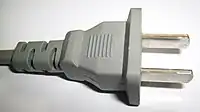 Type A (NEMA 1–15 U.S. 2 pin)
Type A (NEMA 1–15 U.S. 2 pin)
max 125 V AC, max rating 15A, (GB1002 Chinese 2 pin) max 250V AC, max rating 6A or 10A
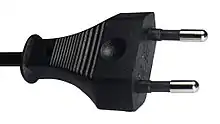
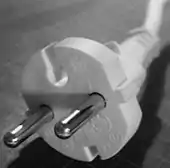
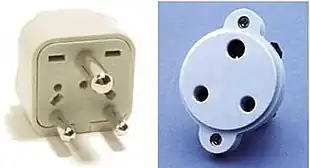


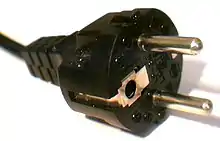
.png.webp)
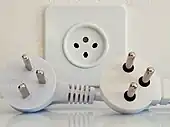 Type H (SI 32 Israel)
Type H (SI 32 Israel) Type I (Australian AS/NZS 3112); Argentinian version has reversed polarity compared to Chinese and Australian versions
Type I (Australian AS/NZS 3112); Argentinian version has reversed polarity compared to Chinese and Australian versions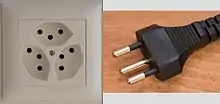 Type J (SN 441011 Switzerland), 10A
Type J (SN 441011 Switzerland), 10A Type K (SRAF 1962/DB Denmark)
Type K (SRAF 1962/DB Denmark) Type L (CEI 23-50)
Type L (CEI 23-50) Type M (15 A BS 546)
Type M (15 A BS 546) Type N (NBR 14136, Brazil and SANS 164-2, South Africa)
Type N (NBR 14136, Brazil and SANS 164-2, South Africa)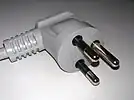 Thai TIS 166-2549 mains plug, often known as Type O[3]
Thai TIS 166-2549 mains plug, often known as Type O[3]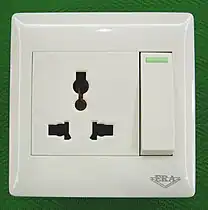
Table of mains voltages, frequencies, and plugs
| Country or territory | Plug type[lower-alpha 1] | National plug standard[2] |
Residential voltage[7] |
Three-phase[8] voltage (L–L) |
Frequency[7] | Notes |
|---|---|---|---|---|---|---|
| C, F | 220 V | 380 V | 50 Hz | |||
| C, F | 230 V | 400 V | 50 Hz | |||
| C, F | 230 V | 400 V | 50 Hz | |||
| A, B, F, I | 120 V | 208 V | 60 Hz | |||
| C, F | 230 V | 400 V | 50 Hz | |||
| C, F | 220 V | 380 V | 50 Hz | |||
| A, B | 110 V | 120/208 V 127/220 V 240/415 V | 60 Hz | |||
| A, B | 230 V | 400 V | 60 Hz | |||
| C, I | IRAM 2073 | 220 V[9] | 380 V | 50 Hz | Line/neutral reversed compared to Chinese and Australian/NZ Type I. | |
| C, F | 230 V | 400 V | 50 Hz | |||
| A, B, F | 127 V | 220 V | 60 Hz | |||
| I | AS/NZS 3112 | 230 V 240 V |
415 V | 50 Hz | Nominal voltage is 230 V, in practice 240 V is more commonly used. | |
| C F | ÖVE-IG/EN 50075 ÖVE/ÖNORM E 8620 | 230 V | 400 V | 50 Hz | ||
| C, F | 220 V | 380 V | 50 Hz | |||
| A, B | 120 V | 208 V | 60 Hz | |||
| G | 230 V | 400 V | 50 Hz | |||
| A, C, D, G, K | 220 V | 380 V | 50 Hz | |||
| A, B | 115 V | 200 V | 50 Hz | |||
| C, F | 230 V[10] | 400 V | 50 Hz | |||
| C, E | NBN C 61 112-1 | 230 V | 230/400 V | 50 Hz | ||
| A, B, G | 110 V 220 V |
190 V 380 V | 60 Hz | |||
| C, E | 220 V | 380 V | 50 Hz | |||
| A, B | 120 V | 208 V | 60 Hz | |||
| C, D, F, G, M | 230 V | 400 V | 50 Hz | |||
| A, C | 115 V 230 V |
400 V | 50 Hz | |||
|
A, B | 127 V | 220 V | 50 Hz | Sockets for 220-240 V European type C plugs are typically available at hotels; some buildings modify voltage, so travellers are advised to check before plugging in. Type F are also available at some hotels. | |
| C, F | 230 V | 400 V | 50 Hz | |||
| D, G, M | 230 V | 400 V | 50 Hz | |||
| C, N | NBR 14136 | 127 V 220 V[15] |
220 V 380 V | 60 Hz[16] | Before standardization, socket types varied: C (very old installations), I (for air conditioners), and combinations like A/C and A/B/C. | |
| A, B | 110 V | 190 V | 60 Hz | |||
| G | 240 V | 415 V | 50 Hz | |||
| C, F | 230 V | 400 V | 50 Hz | |||
| C, E | 220 V | 380 V | 50 Hz | |||
| C, E | 220 V | 380 V | 50 Hz | |||
| A, C, G | 230 V | 400 V | 50 Hz | Sockets for British type G plugs are mainly found at some hotels and never in households. | ||
| C, E | 220 V | 380 V | 50 Hz | |||
| A B NEMA 14-30 NEMA 14-50 |
CSA C22.2 No. 42[17] | 120 V 120 V[18] 240 V 240 V |
120/208 V 240 V 277/480 V 347/600 V |
60 Hz | Homes are typically provided with 120/240 V split-phase power; NEMA 14-30R and 14-50R receptacles are provided on 240 V circuits for clothes dryers and electric stoves.[19] | |
| C, F | 220 V | 400 V | 50 Hz | |||
| A, B | 120 V | 240 V | 60 Hz | |||
| C, E | 220 V | 380 V | 50 Hz | |||
| C, D, E, F | 220 V | 380 V | 50 Hz | |||
| C, F, L | 220 V | 380 V | 50 Hz | L is the national official standard; C and F are compatible. Schuko or type F plugs are often used for high power appliances. | ||
| A, C, I | GB/T 1002 GB/T 2099 | 220 V | 380 V | 50 Hz | Line/neutral reversed compared to Argentinian Type I. | |
| A, B | 120 V[20] | 120/208 V 277/480 V 120/240 V 240/208/120 V 240 V 480 V |
60 Hz[21] | NEMA 5-20R outlets, which are similar to type B but have a T-shaped neutral slot, are sometimes used for higher current 120 V commercial equipments (up to 20 A). On the other hand, NEMA 10-50P outlets are sometimes used for 208 V and 240 V industrial equipments (up to 50 A). | ||
| C, E | 220 V | 380 V | 50 Hz | |||
| C, E | 230 V | 400 V | 50 Hz | |||
[22] |
C, D, E | 220 V | 380 V | 50 Hz | ||
| I | 240 V | 415 V | 50 Hz | |||
| A, B | 120 V | 208 V 240 V 480 V[23] |
60 Hz | |||
| C, E | 230 V | 380 V | 50 Hz | |||
| C, F | 230 V | 400 V | 50 Hz | |||
| A, B, C, L | 110 V | 190 V | 60 Hz | Some modern hotels have 220 V sockets for European 2-pin plugs (Type C).[24] | ||
| A,[25] B | 127 V[25][26] | 220 V 380 V |
50 Hz[25] | Some hotels and apartments have 220 V European sockets.[27] | ||
| G | 240 V | 400 V | 50 Hz | |||
| C, E | ČSN 35 4516 | 230 V | 400 V | 50 Hz | ||
| C, E, F, K | DS/EN 50075 DS 60884-2-D1[28] | 230 V | 400 V | 50 Hz | Type E and F sockets are rare but legal, type E, F and 7/7 plugs work as type C (unearthed) | |
| C, E | 220 V | 380 V | 50 Hz | |||
| D, G | 230 V | 400 V | 50 Hz | |||
| A, B, C | 110 V | 10/208 V 277/480 V | 60 Hz | |||
| A, B | 120 V | 208 V 480 V | 60 Hz | |||
| C, F | 220 V | 380 V | 50 Hz | |||
| A, B | 115 V | 208 V 220 V 440 V 480 V[29] |
60 Hz | |||
| C, E | 220 V | unavailable | 50 Hz | |||
| C, L | 230 V | 400 V | 50 Hz | |||
| C, F | 230 V | 400 V | 50 Hz | |||
| M | 230 V | unavailable | 50 Hz | |||
| C, E, F, L | 220 V | 380 V | 50 Hz | Type E is very rare because Ethiopia never had French influences. | ||
| G | 240 V | 415 V | 50 Hz | |||
| C, E, F, K | 230 V | 400 V | 50 Hz | Same as in Denmark | ||
| I | AS/NZS 3112 | 240 V | 415 V | 50 Hz | ||
| C F | SFS-EN 50075 SFS 5610 | 230 V | 400 V | 50 Hz | ||
| C, E, F | NF EN 50075 NF C 61-314 | 230 V | 400 V | 50 Hz | ||
| C, E | 220 V | 380 V | 50 Hz | |||
| A, B, C, E, F | 110 V 220 V |
380 V | 60 Hz[30] | |||
| C | 220 V | 380 V | 50 Hz | |||
| G | 230 V | 400 V | 50 Hz | |||
| C, F | 220 V | 380 V | 50 Hz | |||
| C F IEC 60309 | DIN VDE 0620 DIN 49441 DIN EN 60309 | 230 V | 400 V | 50 Hz | ||
| D, G | 230 V | 400 V | 50 Hz | |||
| C, G | 240 V | 400 V | 50 Hz | |||
| C, F | 230 V | 400 V | 50 Hz | |||
| C, E, F, K | 230 V | 400 V | 50 Hz | |||
| G | 230 V | 400 V | 50 Hz | |||
| C, D, E | 230 V | 400 V | 50 Hz | |||
| A, B | 110 V | 190 V | 60 Hz | |||
| A, B | 120 V | 208 V | 60 Hz | |||
| G | 230 V | 400 V | 50 Hz | |||
| C, F, K | 220 V | 380 V | 50 Hz | |||
| C, E, F | 220 V | 380 V | 50 Hz | |||
| A, B, D, G | 110 V 220 V[31] |
190 V | 60 Hz 50 Hz[31] | Conversion of 50 Hz distribution to 60 Hz is ongoing[32] | ||
| A, B | 110 V | 220/380 V 110/220 V | 60 Hz | |||
| A, B | 110 V | 208 V 230 V 240 V 460 V 480 V |
60 Hz | |||
| G D, M[33] | BS 1363 BS 546 | 220 V | 380 V | 50 Hz | Type G is most common. | |
| C F | MSZ EN 50075 MSZ 9781-2 | 230 V | 400 V | 50 Hz | ||
| C, F | 230 V | 400 V | 50 Hz | |||
| C, D, M | IS 1293[34] | 230 V[7] | 400 V[35] | 50 Hz | (1) It is worth noting that the combination of a Type C, E or F plug with a Type D socket may often be workable; but it is unsafe to use.[36][37] Type C, E & F plugs/sockets are not accepted in the IS 1293 standard. The standard uses Type D sockets for 6 A current and Type M sockets for 16 A current.[38][39][40][41]
(2) From August 2015, the Bureau of Indian Standards (BIS) began clamping down on the sale in the country of imported products with the Type C/E/F plug by pushing manufacturers and importers to comply with the IS 1293 standard.[42] In June 2022, BIS began enforcing the standard through mandatory certification of both imported and domestic products.[43] | |
| A, C, F, G | SNI 04-3892 | 230 V | 400 V | 50 Hz | Types C and F plugs are most used. British Type G sockets are common in Riau Islands due to their close proximity to Singapore. British Type G sockets are also used for air conditioners, because most draw more current than the rating of most sockets in Indonesia. Wall sockets in most homes in North Sumatra (in cities such as in Medan and Pematangsiantar) generally accept both Type A and Type C plugs. | |
| C, F | 220 V | 400 V | 50 Hz | |||
| C, D, G | 230 V | 400 V | 50 Hz | |||
| G | I.S. 401[44] | 230 V | 400 V | 50 Hz | Type G is the only general purpose outlet type in use in Ireland. Bathrooms may have shaver sockets. These accept 2.5 amp Europlug CEE 7/16 and UK type BS4573 plugs, which used on shavers and toothbrushes. They do not accept larger Type C plugs and general purpose outlets are generally banned in bathrooms / wet areas. Some hotels may also provide a Type F (Schuko) socket as a convenience for European visitors. | |
| G | 230 V | 400 V | 50 Hz | Self-governing British crown dependency, but generally uses UK technical standards. | ||
| C, H | 230 V | 400 V | 50 Hz | |||
| C F, L | CEI 23-34 CEI 23-50 | 230 V | 400 V | 50 Hz | Type L uses two gauges of plug and socket. The 10 Amp version has pin spacing that is compatible with Europlug. The 16 Amp version uses wider pin spacing and larger pins. Hybrid outlets that accept both types are common and some also accept type F. NB: 16 Amp Type C plugs, such as CEE 7/17 commonly found on hairdryers, will not fit Type L outlets and need an adapter, or should be used with a Type F or hybrid Type L/F outlet. | |
| A, B | 110 V | 190 V | 50 Hz | |||
| A, B | JIS C 8303 | 100 V 200 V |
200 V 415 V |
50 Hz 60 Hz | East Japan 50 Hz (Tokyo, Kawasaki, Sapporo, Yokohama, and Sendai); West Japan 60 Hz (Okinawa, Osaka, Kyoto, Kobe, Nagoya, Hiroshima). 120 V in military facilities in Okinawa.[45] Majority of sockets accept only type A plugs. See Energy in Japan for more. | |
| G | 230 V | 400 V | 50 Hz | |||
| B, C, D, F, G, J | 230 V | 400 V | 50 Hz | |||
| C, F | 230 V | 400 V | 50 Hz | 230/400V voltage is defined in "GOST 29322-2014 Mezhgosudarstvennyi Standart Napryazheniya Standartnye". | ||
| G | 240 V | 415 V | 50 Hz | |||
| I | 240 V | unavailable | 50 Hz | |||
| C, F | 230 V | 230 V 400 V | 50 Hz | |||
| C, G | 240 V | 415 V | 50 Hz | |||
| C, F | 220 V | 380 V | 50 Hz | |||
| A, B, C, E, F | 230 V | 400 V | 50 Hz | Some buildings and households have hybrid sockets compatible with type A, B and C. | ||
| C, F | 230 V | 400 V | 50 Hz | |||
| A, B, C, D, G | 220 V | 400 V | 50 Hz | Type C sockets are the most frequent. Many buildings and households have double use sockets compatible with type A and C. | ||
| M | 220 V | 380 V | 50 Hz | |||
| A, B, C, E, F | 120 V 220 V |
208 V | 60 Hz 50 Hz | |||
| C, D, F, L | 127 V 230 V |
400 V | 50 Hz | Barca, Benghazi, Derna, Sabha & Tobruk 230 V. | ||
| C, J | 230 V | 400 V | 50 Hz | |||
| C, F | 230 V | 400 V | 50 Hz | |||
| C, F | 230 V | 400 V | 50 Hz | |||
| D, F, G, M | 230 V[46] | 400 V | 50 Hz | |||
| C, D, E, J, K | 127 V 220 V |
380 V | 50 Hz | |||
| G | 230 V | 400 V | 50 Hz | |||
| C[47] G[47] M[47][48] | MS 1578:2003[47] MS 589:PT.1:1997[47] MS 1577:2003[47] | 230 V[49] | 400 V | 50 Hz | Type C requires adaptor.[50] Bathrooms may have shaver supply units.[50] Type M used mainly for air conditioners and boilers. | |
| D, G, J, K, L | 230 V | 400 V | 50 Hz | |||
| C, E | 220 V | 380 V | 50 Hz | |||
| G | 230 V | 400 V | 50 Hz | |||
| C, D, E | 220 V | 380 V | 50 Hz | |||
| C, E, F | 220 V | 220 V | 50 Hz | |||
| C, E, G | 230 V | 400 V | 50 Hz | |||
| A, B | NMX-J-163-ANCE | 127 V | 220 V | 60 Hz | ||
| A, B | 120 V | unavailable | 60 Hz | |||
| C, F | 220 V | 400 V | 50 Hz | |||
| C, D, E, F | 230 V | 400 V | 50 Hz | |||
| C, E, F | 220 V | 400 V | 50 Hz | |||
| C, F | 230 V | 400 V | 50 Hz | |||
| A, B | 230 V | 400 V | 60 Hz | |||
| C, E | 127 V 220 V |
380 V | 50 Hz | |||
| C, F, M | 220 V | 380 V | 50 Hz | |||
| A, C, D, G, I | 230 V | 400 V | 50 Hz | |||
| D, M | 220 V | 380 V | 50 Hz | |||
| I | 240 V | 415 V | 50 Hz | |||
| C, D, M | 230 V | 400 V | 50 Hz | |||
| C, F | EN 50075 NEN 1020 | 230 V | 400 V | 50 Hz | ||
| C, F | 220 V | 380 V | 50 Hz | Despite that New Caledonia is a French territory, German Schuko Type F sockets are used instead of French Type E sockets. | ||
| I | AS/NZS 3112 | 230 V | 400 V | 50 Hz | Line/neutral reversed compared to Argentinian Type I. | |
| A, B | 120 V | 208 V | 60 Hz | |||
| A, B, C, D, E, F | 220 V | 380 V | 50 Hz | |||
| D, G | 230 V | 415 V | 50 Hz | |||
| A, C, F | 110 V 220 V |
380 V | 60 Hz 50 Hz | |||
| C, F | 230 V | 400 V | 50 Hz | |||
| C F | NEK EN 50075 NEK 502 | 230 V | 230 V 400 V |
50 Hz | 230 V on IT grid, and 400 V on TN grid. | |
| C, G | 240 V | 415 V | 50 Hz | |||
| C, D, G, M | 230 V | 400 V | 50 Hz | |||
| A, B | 120 V | 208 V | 60 Hz | |||
| C, H | 230 V | 400 V | 50 Hz | |||
| A, B | 110 V | 240 V | 60 Hz | |||
| I | 240 V | 415 V | 50 Hz | |||
| A, C | 220 V | 380 V | 50 Hz | |||
| A, B, C F, L[51] | 220 V | 380 V 440 V | 60 Hz | |||
| A, B, C | 115 V 230 V[52] |
220 V 380 V 440 V |
60 Hz | 50 Hz used in some establishments such as malls. | ||
| C, E | BN-88/3064 | 230 V | 400 V | 50 Hz | ||
| C, E, F | NP 1260 | 230 V | 400 V | 50 Hz | Type E is very rare, used only in very old installations. | |
| A, B | 120 V | 480 V | 60 Hz | |||
| D, G | 240 V | 415 V | 50 Hz | |||
| E | 220 V | 400 V | 50 Hz | |||
| C, F | 230 V | 400 V | 50 Hz | |||
| C, F | 230 V[10] | 400 V | 50 Hz | USSR (along with much of Eastern Europe) used GOST sockets with 4.0 mm pins similar to Type C plugs and the 4.8 mm standard used by Type E & F.[53] | ||
| C, E, F, G | 230 V | 400 V | 50 Hz | |||
| G | 220 V 240 V |
unavailable | 50 Hz | |||
| C, E | 220 V | unavailable | 60 Hz | |||
| A, B | 120 V | 220 V | 60 Hz | |||
| A, B, D, G | 230 V | 400 V | 60 Hz | |||
| G | 240 V | 400 V | 50 Hz | |||
| C, E, F[54] | 230 V | unavailable | 50 Hz | |||
| C, E, G, I, K | 230 V | 400 V | 50 Hz | |||
| I | 230 V | 400 V | 50 Hz | |||
| C, F, L | 230 V | 400 V | 50 Hz | |||
| C, F | 220 V | 400 V | 50 Hz | |||
| G | SASO 2203 | 220/230 V | 380 V | 50 Hz 60 Hz | ||
| C, D, E, K | 230 V | 400 V | 50 Hz | |||
| C F | JUS N.E3.552 JUS N.E3.553 | 230 V | 400 V | 50 Hz | ||
| G | 240 V | 240 V | 50 Hz | |||
| D, G | 230 V | 400 V | 50 Hz | |||
| C G M | SS 145 SS 472 | 230 V | 400 V | 50 Hz | ||
| C, E, F | STN 34 4516 | 230 V | 400 V | 50 Hz | ||
| C, F | 230 V | 400 V | 50 Hz | |||
| G, I | 220 V | unavailable | 50 Hz | |||
| C | 220 V | 380 V | 50 Hz | |||
| C, M, N | SANS164 | 230 V | 400 V | 50 Hz | ||
| C, F | KS C 8305 | 220 V | 380 V | 60 Hz | ||
| C, F | UNE 20315 | 230 V | 400 V | 50 Hz | Type E is extremely rare, but it may appear in some buildings, such as the University Carlos III of Madrid. Almost every Spanish plug would work on Type E sockets. | |
| D, G | SLS 734 | 230 V | 400 V | 50 Hz | Only Type G permitted to be manufactured or imported from August 2017[55] | |
| C, D | 230 V | 400 V | 50 Hz | |||
| A, B, C, F | 127 V | 220 V 400 V |
60 Hz | Type A and B tend to be very common because standard sockets can't accommodate such voltage. | ||
| C F IEC 60309 | SS-EN 50075 SS 428 08 34 SS-EN 60309 | 230 V | 400 V | 50 Hz | Bathrooms may have shaver supply units. | |
| C, J | SN SEV 1011:2009[56][57] | 230 V | 400 V | 50 Hz | ||
| C, E, L | 220 V | 380 V | 50 Hz | |||
| A, B | CNS 690 CNS 15767 | 110 V | 220 V 380 V |
60 Hz | Sockets in older buildings are often unearthed and accept only Type A plugs. | |
| C, F, I | 220 V | 380 V | 50 Hz | |||
| D, G | 230 V | 415 V | 50 Hz | |||
| A, B, C, F | 220 V | 400 V | 50 Hz | There is also a Thai national standard, TIS 166-2549 (sometimes known as Type O) which may not yet be in common use.[58][59] | ||
| C, E, F, I | 220 V | 380 V | 50 Hz | |||
| C | 220 V | 380 V | 50 Hz | |||
| I | 240 V | 415 V | 50 Hz | |||
| A, B | 115 V | 115/230 V 230/400 V | 60 Hz | |||
| C, E | 230 V | 400 V | 50 Hz | |||
| C, F | 230 V[60] | 400 V | 50 Hz | |||
| B, C, F | 220 V | 380 V | 50 Hz | |||
| I | 220 V | unavailable | 50 Hz | |||
| G | 240 V | 415 V | 50 Hz | |||
| C, F | 230 V[61][62] | 400 V | 50 Hz | |||
| G[63] | BS 1363[63] | 230 V[64] | 400 V[64] | 50 Hz[64] | Bathrooms may have shaver supply units[63] | |
| G[65] D, M[66] | BS 1363 BS 546 |
230 V[67] | 400 V | 50 Hz | D, M historical only, vanishingly rare. Bathrooms may have shaver supply units | |
| | A B NEMA 14-30 NEMA 14-50 | NEMA 1-15 NEMA 5-15 NEMA 14-30 NEMA 14-50 | 120 V 120 V 240 V 240 V |
120/208 V 277/480 V 120/240 V 240 V 480 V |
60 Hz | NEMA 5-20R outlets, which are similar to type B but have a T-shaped neutral slot, are sometimes used for higher current 120 V equipment (up to 20 A). |
| A B | NEMA 1-15 P NEMA 5-15 P | 110 V | 190 V | 60 Hz | ||
| C, F, I, L | 230 V | 380 V | 50 Hz | |||
| C, I | 220 V | 380 V | 50 Hz | |||
| C, G, I | 220 V | 400 V | 50 Hz | |||
| A, B | 120 V 208 V 240 V |
115/220 V 220/440 V 230/460 V[68] |
60 Hz | |||
| A, B, C, D, G | TCVN 6188-1 | 220 V | 380 V | 50 Hz | Majority of households use unearthed hybrid sockets that accept type A and C plugs. Hybrid sockets that accept type A, B and C plugs are sometimes used in commercial installations. Sockets for British type G plugs are found at some hotels and never in households. | |
| A, D, G | 240 V | 400 V | 50 Hz | |||
| C, D, G | 230 V | 400 V | 50 Hz | |||
| D, G | 220 V | 415 V | 50 Hz |
- "C" may indicate that buildings have three-pin sockets compatible with Europlugs, which also work with other plug types or that buildings have some or all two-pin European style sockets, similar to CEE 7/1, or that use of an adaptor is common practice. Not all two-pin European plugs are compatible with all two-pin European sockets; see AC power plugs and sockets § Compatibility.
See also
References
- World Plugs Archived 10 October 2018 at the Wayback Machine. International Electrotechnical Commission (IEC). Retrieved on 2018-06-05.
- IEC/TR 60083 ed7.0: Plugs and socket-outlets for domestic and similar general use standardized in member countries of IEC. International Electrotechnical Commission, October 2015. This 421-page technical report describes many national standards for domestic plugs and sockets. The first edition was published in January 1957. The 7th edition was approved in December 2012 and was published on 29 October 2015.
- "WorldStandards.eu - Power plug & outlet Type O". Archived from the original on 24 July 2020. Retrieved 25 July 2020.
- "Universal AC Outlet • Setup Guide" (PDF). Anaheim, CA: Extron Electronics. November 2017. 68-1638-01 Rev. F. Archived from the original (PDF) on 16 May 2018. Retrieved 21 May 2018.
- "Alert noting non-compliant power strips" (PDF). 2009. Archived from the original (PDF) on 6 March 2016. Retrieved 25 October 2019.
- "Sri Lanka Sets National Standard for Plugs and Socket Outlets". Public Utilities Commission of Sri Lanka. Archived from the original on 2 April 2019. Retrieved 25 October 2019.
Standardized on Type G; sale of non-compliant sockets is banned as of August, 2018, and buildings must re-wire by August, 2038.
- "IEC World Plugs". IEC World Plugs. International Electrotechnical Commission. Archived from the original on 10 October 2018. Retrieved 30 April 2021.
- "Three-phase electric power (industrial applications only)" (Archived copy). Archived from the original on 20 December 2022. Retrieved 20 December 2022.
- Reglamentado por AEA90364, IRAM2001 & IEC60083
- "Standard Voltages". docs.cntd.ru. Archived from the original on 21 September 2018. Retrieved 11 August 2014. Document gost-29322-92 via Google Translate: "The nominal voltages of the existing 220/380 and 240/415 V networks should be gradually changed to the recommended value of 230/400 V. Until 2003, as a first stage, power supply companies in countries with a 220/380 V network should lead the voltage to The value of 230/400 V (GOST 29322-92 (IEC 38-83) Standard voltage%). Electricity supply companies in regions with 240/415 V network should also bring this voltage to the value 230/400 V (GOST 29322-92 (IEC 38-83) Standard voltage%). After 2003, the range of 230/400 V ± 10% should be reached. Then, the issue of reducing the limits will be considered."
- "Electrical Plug/Outlet and Voltage Information for Bonaire". Adaptelec.com. Archived from the original on 12 June 2018. Retrieved 25 May 2018.
- "F.A.Q." CaribbeanClubBonaire.com. Archived from the original on 26 May 2018. Retrieved 25 May 2018.
- "Technology on Bonaire". InfoBonaire.com. Archived from the original on 26 May 2018. Retrieved 25 May 2018.
- "Electricity". CaribInn.com. Archived from the original on 12 June 2018. Retrieved 25 May 2018.
- Brasil. Decreto n. 41.019, de 26 de fev. de 1957. Regulamenta os serviços de energia elétrica, BR: BR Government, 1957, archived from the original on 18 April 2019, retrieved 7 January 2018
- Brasil. Lei n. 4.454, de 06 de nov. de 1964. Dispõe sobre a unificação de frequência da corrente elétrica no País, BR: BR Government, 1964, archived from the original on 10 July 2019, retrieved 7 January 2018
- CSA Standard C22.2 No. 42-10: General use receptacles, attachment plugs, and similar wiring devices. Mississauga, Ontario: Canadian Standards Association. 2010. p. 1.
- CAN3-C235-83: Preferred Voltage Levels for AC Systems, 0 to 50 000 V. Rexdale (Toronto), Ontario: Canadian Standards Association. 1983. p. 9.
- C22.1-18: Canadian Electrical Code, Part 1. Toronto, Ontario: Canadian Standards Association. 2018. p. 243.
- Colombia. Resolución 90708: Reglamento Técnico de Instalaciones Eléctricas - RETIE, August 30, 2013, CO: Ministry of Mines and Energy, 2013, archived from the original on 11 July 2015, retrieved 16 October 2018
- Colombia. CREG RESOLUCIÓN No. 70, May 28, 1998, CO: Commission for the Regulation of Energy and Gas (CREG), 1998, archived from the original on 17 October 2018, retrieved 16 October 2018
- "List of Voltages & Frequencies (Hz) Around the World" (Archived copy). Archived from the original on 23 November 2022. Retrieved 20 December 2022.
- Tensiones Transitorias - Boletín Informativo (PDF), CR: CNFL - Compañía Nacional de Fuerza y Luz S.A., archived (PDF) from the original on 17 August 2021, retrieved 20 April 2020
- "Cuba: Electricity - TripAdvisor". Archived from the original on 12 June 2018. Retrieved 10 June 2018.
- "Curaçao Utilities". Curaçao Tourist Board. Archived from the original on 12 June 2018. Retrieved 28 June 2017.
- Confirmed 127V by looking at Aqualetric residential electricity meter
- "Do I need special plugs/adaptors for my devices in Curaçao?". Archived from the original on 17 September 2021. Retrieved 17 September 2021.
- Dansk Standard. "DS 60884-2-D1:2011 - Plugs and socket-outlets for household and similar purposes - Requirements for Danish systems". webshop.ds.dk. Archived from the original on 8 January 2014. Retrieved 8 January 2014.
- Netzspannungen Weltweit (PDF), Fuhrmeister + Co GmbH, 2020, archived (PDF) from the original on 18 August 2021, retrieved 20 April 2020
- "Calculez votre consommation". EDT ENGIE (in French). page 10, article 9. Archived from the original on 2 February 2020.
- History of Guyana Power and Light Archived 30 April 2018 at the Wayback Machine. Gplinc.com. Retrieved on 2014-01-01.
- GPL Converting Parts of the City to 60 Hz, retrieved 2009 July 31 Archived 17 August 2009 at the Wayback Machine. Stabroeknews.com (2009-07-10). Retrieved on 2014-01-01.
- "Code of Practice for the Electricity (Wiring) Regulations" (PDF). Electrical and Mechanical Services Department. p. 221. Archived (PDF) from the original on 25 October 2018. Retrieved 28 May 2016.
- October 2005. IS 1293 - Indian Standard - PLUGS AND SOCKET-OUTLETS OF RELATED VOLTAGE UP TO AND INCLUDING 250 VOLTS AND RATED CURRENT YP TO AND INCLUDING 16 AMPERES -- SPECIFICATION Archived 3 March 2016 at the Wayback Machine. Bureau of Indian Standards.
- "National Electrical Code 2011" (PDF). Bureau of Indian Standards. Archived (PDF) from the original on 30 December 2021. Retrieved 30 December 2021.
- "Power plug & outlet Type D". WorldStandards. Retrieved 9 May 2023.
- Type of plug & socket around the world, retrieved 10 May 2023
- Bureau of Indian Standards (2005). IS 1293: Plugs and socket- outlets of rated voltage up to and including 250 volts and rated current up to 16 amperes. Public.Resource.Org.
- "Information to Industry regarding implementation of IS 1293" (PDF). Bureau of Indian Standards.
- "New version of IS standard for plugs and sockets". India Certification – Your expert for India Certifications. 23 December 2020. Retrieved 9 May 2023.
- "IS 1293 : What are the different kinds of Indian electrical sockets? · Sid Verma". sidverma.io. Retrieved 9 May 2023.
- "Department of Electronics and IT upset with BIS's abrupt enforcing of technical standards". The Economic Times. 21 April 2015. ISSN 0013-0389. Retrieved 9 May 2023.
- Agarwal, Anil. "S.O. 2166(E)" (PDF). DPIIT - Government of India.
- I.S. 401, "Safety requirements for rewirable and non-rewirable 13A fused plugs for normal and rough use having insulating sleeves on line and neutral pins", NSAI (National Standards Authority of Ireland), (1997), Dublin
- MC&FP, Military Community Outreach. "MilitaryINSTALLATIONS - U.S. Department of Defense". www.militaryinstallations.dod.mil. Archived from the original on 13 July 2018. Retrieved 13 July 2018.
- "Standard Conditions of Supply of Electricity" (PDF). Archived (PDF) from the original on 21 December 2022. Retrieved 20 December 2022.
- Plug Top/Plug (15 A and below) -Energy Commission of Malaysia. Archived from the original 2015-01-07.
- "Guidelines For Electrical Wiring In Residential Buildings" (PDF) (2008 ed.). Energy Commission of Malaysia. Archived (PDF) from the original on 10 October 2018. Retrieved 30 October 2013.
- Voltan Nominal Archived 12 February 2019 at the Wayback Machine. Malaysian Energy Commission Notice (Nominal Voltage - 2008-01-01). Retrieved on 2019-02-11
- Socket Outlet (15 A and below) Archived 2015-01-07 at the Wayback Machine Energy Commission of Malaysia. (MS 1579:2003 is adaptor for Europlugs.)
- "MEM recomienda qué tipo de tomacorrientes se deben utilizar". Diario Correo (in Spanish). 24 January 2016. Archived from the original on 29 March 2019. Retrieved 26 August 2019.
- "Philippine Electrical Code, section 2.20.1.5 (a)" (PDF). Archived (PDF) from the original on 29 March 2017. Retrieved 28 March 2017.
- ГОСТ 7396.1–89 - Plugs (Electrical) and socket-outlets for domestic and similar general use. Standards. Archived 3 December 2013 at the Wayback Machine Elec.ru (2013-01-30). Retrieved on 2013-02-05.
- "Before your stay". Tourism Office of Saint Pierre et Miquelon. Archived from the original on 18 January 2022. Retrieved 1 March 2022.
- "New standards for 13A plugs and socket outlets manufactures & importers" (Press release). Public Utilities Commission of Sri Lanka. 13 June 2018. Archived from the original on 31 March 2018. Retrieved 17 April 2019.
- "Information SEV 1011 – power socket/plug/connector" (PDF). esti.admin.ch (PDF). Federal Inspectorate for Heavy Current Installations ESTI, Swiss Confederation. 1 August 2011. Archived from the original (PDF) on 25 April 2012. Retrieved 22 August 2014.
- "New standard for plugs in Switzerland starting from 2013" (PDF) (PDF). Federal Inspectorate for Heavy Current Installations ESTI, Swiss Confederation. 13 May 2011. Archived (PDF) from the original on 26 May 2013. Retrieved 22 August 2014.
- TIS 166-2549 (2006): Thai Industrial Standards for Plugs and socket-outlets for household and similar purposes : plugs and socket-outlets with rated voltage not exceeding 250 V (English translation) Archived from the original 2016-07-07.
- TIS 166-2549 (2006) THAI INDUSTRIAL STANDARD - PLUGS AND SOCKET–OUTLETS FOR HOUSEHOLD AND SIMILAR PURPOSES : PLUGS AND SOCKET–OUTLETS WITH RATED VOLTAGE NOT EXCEEDING 250 V (Original Thai) ISBN 974-9815-94-7
- "ELEKTRONİK ELEKTRİK SAYAÇLARI TEKNİK ŞARTNAMESİ" (PDF). Archived (PDF) from the original on 16 September 2021. Retrieved 16 September 2021.
- "ДСТУ ЕN 50160:2014" (PDF). Archived (PDF) from the original on 16 May 2021. Retrieved 11 March 2020.
- Temporarily the nominal voltage in the low-voltage network is 220V
- THE ELECTRICITY WIRING REGULATIONS (2020) (PDF). Abu Dhabi Department of Energy. p. 51. Archived from the original (PDF) on 1 November 2022.
- THE ELECTRICITY SUPPLY REGULATIONS (2020) (PDF). Abu Dhabi Department of Energy. 2020. p. 18. Archived from the original (PDF) on 1 November 2022.
- Mullins, Malcolm (Spring 2006). "The Origin of the BS 1363 Plug and Socket-Outlet System". IEE Wiring Matters. Institute of Electrical Engineers. Archived from the original on 3 March 2016. Retrieved 16 October 2016.
- "Museum of Plugs and Sockets: BS 546 plugs and sockets". www.plugsocketmuseum.nl. Archived from the original on 30 September 2022. Retrieved 6 January 2023.
- The Electricity Safety, Quality and Continuity Regulations 2002 PART VII Regulation 27, UK: UK Government, 2002, archived from the original on 24 May 2019, retrieved 12 September 2013
- "International Mains Voltages" (PDF). International Mains Voltages - Pooley Inc. SEW Eurodrive. Archived (PDF) from the original on 6 May 2020. Retrieved 15 January 2020.
External links
 Electrical systems travel guide from Wikivoyage
Electrical systems travel guide from Wikivoyage Guide to Electrical Equipment for Travelers at Wikibooks
Guide to Electrical Equipment for Travelers at Wikibooks
